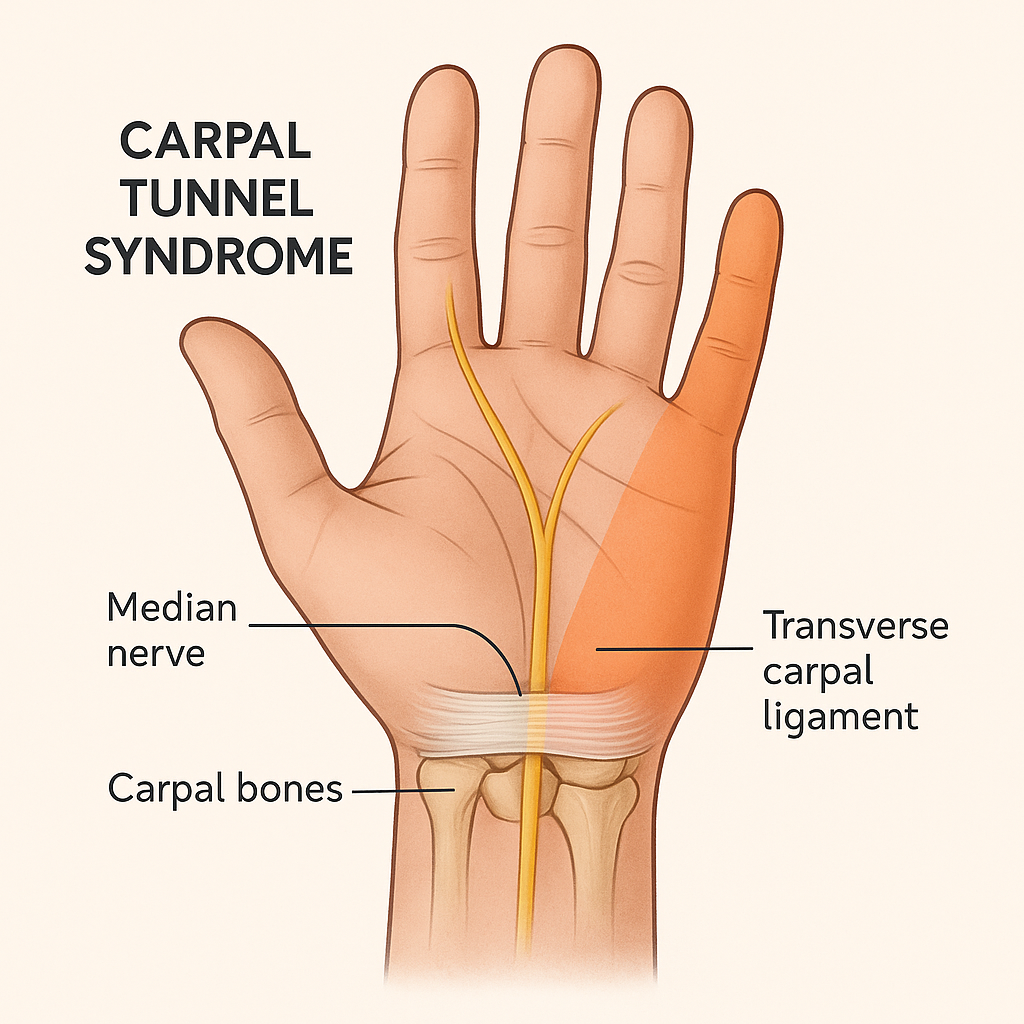What is Carpal Tunnel Syndrome?
Carpal Tunnel Syndrome is a condition that affects the hand and wrist. It happens when the median nerve, which runs from your forearm into your hand, gets compressed at the wrist. This nerve passes through a narrow path in the wrist called the carpal tunnel, made of bones and ligaments.
When this space becomes smaller, or the tissues around the tunnel swell, they put pressure on the median nerve. This causes symptoms like numbness, tingling or weakness in the thumb, index and middle fingers.
The condition usually develops over time. Many patients notice their symptoms worsen at night or after repetitive hand movements. It is one of the most common nerve-compression disorders.

What are the most common symptoms of carpal tunnel syndrome?
The symptoms of carpal tunnel syndrome usually start gradually. They may come and go at first, but tend to get worse over time if not treated. This condition mostly affects the thumb, index, middle and part of the ring finger.
Common symptoms include:
- Numbness or tingling in the fingers, especially at night or in the morning
- Pain that may spread from the wrist up the arm or down to the fingers
- Weakness in the hand, making it hard to grip objects
- A feeling of clumsiness or dropping things frequently
- A burning or electric-shock sensation in the affected fingers
Some people shake their hand to relieve symptoms. If the condition progresses, the muscles at the base of the thumb may shrink. Early diagnosis can prevent permanent nerve damage.
Carpal tunnel syndrome causes
Carpal tunnel syndrome has several causes, most related to increased pressure on the median nerve inside the tunnel. This pressure can result from swelling, injury or repetitive stress.
- Repetitive hand or wrist movements, such as typing, using tools or assembly-line work
- Wrist injuries like fractures or sprains that change the tunnel’s shape
- Medical conditions such as diabetes, rheumatoid arthritis or thyroid disorders
- Fluid retention, especially during pregnancy or menopause
- Obesity, which can increase pressure in the tunnel
- Genetics: some people naturally have a smaller carpal tunnel
Often, several factors combine, and sometimes no single cause is found.
Is carpal tunnel syndrome more common during pregnancy?
Yes. It often develops in the second or third trimester because fluid retention causes swelling around the tunnel, raising pressure on the median nerve. Hormonal changes and weight gain may also contribute.
Symptoms are usually temporary and improve after delivery, but severe cases may need treatment if symptoms persist postpartum.
What occupations and activities increase risk for carpal tunnel syndrome?
Jobs and daily activities that involve repetitive hand and wrist movements or prolonged pressure on the wrist raise the risk:
- Office work: frequent typing or computer-mouse use
- Assembly-line work in manufacturing or food processing
- Construction work with vibrating tools such as jackhammers or drills
- Hairdressing: constant use of scissors and styling tools
- Playing certain musical instruments
- Cashiering with repeated scanning and packaging
- Long-distance driving with prolonged grip on the steering wheel
Poor posture and improper hand positioning increase risk. Breaks and ergonomic tools help reduce strain.
How is carpal tunnel syndrome diagnosed?
Diagnosis combines medical history, physical examination and diagnostic tests:
- Medical history: description of symptoms, duration and triggers
- Physical exam: assessment of numbness, weakness or pain. Common tests include:
- Tinel’s sign: tapping over the median nerve to provoke tingling
- Phalen’s test: bending the wrists to elicit symptoms
- Nerve-conduction study: measures the speed of electrical signals through the median nerve
- Electromyography (EMG): checks muscle activity to rule out other disorders
- Ultrasound or MRI: occasionally used to view tunnel structure or other causes
Early diagnosis prevents permanent nerve damage and preserves hand function.
What non-surgical treatment options are available for carpal tunnel syndrome?
Mild to moderate cases are treated first with non-surgical measures that relieve pressure on the median nerve:
- Wrist splinting, especially at night
- Activity modification to reduce repetitive hand movements
- NSAIDs to reduce pain and inflammation
- Corticosteroid injections for temporary relief
- Physical therapy with stretching and nerve-gliding exercises
- Managing underlying conditions such as diabetes or thyroid disorders
If symptoms persist or worsen, surgery may be required to avoid long-term nerve damage.
When is surgery necessary for carpal tunnel syndrome treatment?
Surgery is considered when non-surgical treatments fail or the condition is severe. Indications include:
- Persistent or worsening symptoms after several weeks or months of conservative care
- Constant numbness, tingling or pain
- Hand weakness or muscle wasting, especially at the thumb base
- Nerve-conduction tests showing significant damage
- Regular sleep interruption due to symptoms
Surgery is safe and effective, particularly when performed before permanent nerve damage occurs. Many resume normal activities within weeks.
What happens during carpal tunnel release surgery?
The procedure relieves pressure on the median nerve by cutting the transverse carpal ligament. Two main techniques:
- Open surgery: a small incision in the palm allows direct view and release of the ligament.
- Endoscopic surgery: a camera and instruments inserted through tiny incisions cut the ligament from inside.
Both methods take 10–30 minutes, usually under local anesthesia, with same-day discharge. The ligament heals with more space, easing symptoms within days or weeks; full recovery may take months.
How is the transverse carpal ligament addressed during the procedure?
- The surgeon identifies the ligament via an open incision or endoscope.
- The ligament is divided to enlarge the tunnel and release nerve pressure.
- It heals as scar tissue, reconnecting with extra space to prevent future compression.
What is recovery like after carpal tunnel surgery?
- First few days: mild soreness or swelling, managed with analgesics.
- Bandage and stitches: stitches removed after 10–14 days.
- Early movement: gentle finger and wrist motion prevents stiffness.
- Return to light activities within days; work in 2–6 weeks, depending on job.
- Full strength and dexterity return over several months.
Ongoing discomfort or weakness is rare and usually temporary.
How can you prevent carpal tunnel syndrome?
While not always preventable, risk can be lowered with good habits:
- Take regular breaks from repetitive tasks
- Maintain neutral wrist posture
- Use ergonomic equipment and proper workstation setup
- Avoid excessive grip force
- Perform stretching and strengthening exercises
- Limit vibration exposure with protective gear
- Manage underlying health conditions
These steps reduce stress on the carpal tunnel and help protect the median nerve.


